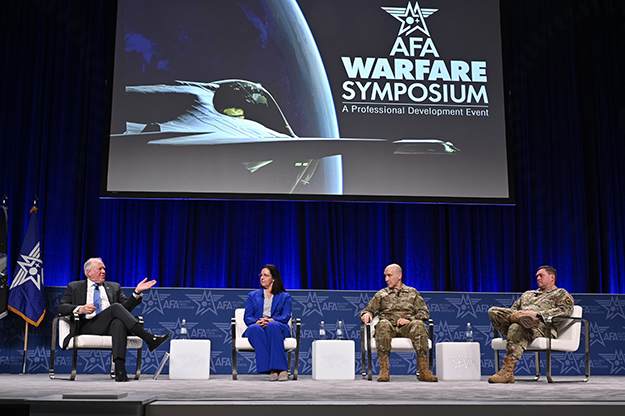To best optimize itself for great power competition, the Air Force plans to, among other things, bring back warrant officers within the cyber and information technology professions, said Air Force Chief of Staff Gen. David W. Allvin during a presentation Feb. 12 at the Air Force Association's 2024 Warfare Symposium.
That change was among two dozen announced by senior Air Force officials. Each change is specifically designed to prepare the service for strategic power challenges from competitors like China and Russia.
"Both China and Russia are actively developing and fielding more advanced capabilities designed to defeat U.S. power projection," said Secretary of the Air Force Frank Kendall. "The need for modernization against capable, well-resourced strategic adversaries never stops. But modernization isn't the only thing we need to do to be competitive. Today we are announcing 24 key decisions we have made to improve both the readiness of the current force and our ability to stay competitive over time, to continuously generate enduring competitiveness."
Those changes, Kendall said, focus on people, readiness, power projection and capability development and are implemented within the Department of the Air Force, the Air Force and the Space Force.
Within the Air Force, Allvin explained, the service is looking to better attract and develop cutting-edge talent, specifically within information technology and cyber fields. The service plans to expand technical tracks for officers and create technical tracks for enlisted, and to also reintroduce the rank of warrant officer within the information technology and cyber fields as a way to maintain technical leadership with those skills.
"We know there are people who want to serve. They just want to code for their country. They would like to be network attack people and do that business," Allvin said. "But everybody needs to see themselves into the future beyond just this assignment or the next. So, developing that warrant officer track for this narrow career field, we anticipate will drive that talent in and help us to keep that talent. There's something specific about this career field, why it's attractive and it's a nice match for a warrant officer program. The pace of change of the cyber world, the coding world, the software world - it is so rapidly advancing, we need those airmen to be on the cutting edge and stay on the cutting edge."
The Air Force had warrant officers when it was created in 1947, after being split off from the U.S. Army. But the service stopped appointing warrant officers in the late 1950s.
Allvin also discussed changes in the way the Air Force will conduct exercises. The plan is for the service to implement large-scale exercises and mission-focused training which encompasses multiple operations plans to demonstrate and rehearse for complex, large-scale military operations, he said.
"We're going to reorient ourselves to more large-scale exercises rather than a smaller scale that have been a product of the last two to three decades," Allvin said. "Large-scale means multiple weapons systems, multiple capabilities, coming together in a combat-simulated environment and showing our ability to execute the mission that's going to be expected of us in the high-end conflict."
Exercises in recent years, he said, have already been getting bigger. But those enhancements have been driven at the local level, not from the top down. That will change.
"Our Air Force needs to institutionalize this," he said. "And we're going to do that."
He said the Air Force is looking at fiscal year 2025 for its first large-scale, multi-combatant command exercise targeted at Indo-Pacom.
Chief of Space Operations Gen. B. Chance Saltzman said a change underway within the Space Force is to enhance readiness by implementing standards that reflect operations under contested conditions rather than those of a benign environment.
"The legacy force that we had, our roots ... were built around efficiency, built around a benign environment," he said. "So, the standards for readiness that we kind of held our forces to was different. It wasn't built for the domains that we're facing, a contested domain."
Now, Saltzman said, the Space Force must rewrite its standards for readiness centered around a contested domain, rather than an uncontested domain.
That, he said, means in part having the right mix of officers, enlisted personnel and civilians in Space Force units. It also means training must be aimed at more than just procedural competency.
"As soon as you put a red force in the mix, as soon as you put a threat in the mix, it radically changes your training," he said. "You have to have advanced training, you have to have tactics training, you have to understand how you work together, in-comms, out of comms, with other units, in order to continue to achieve the kinds of effects in a contested domain when an adversary, a capable adversary, is doing everything they can to stop you from being successful."
Space Force, he said, will build a training infrastructure and a test infrastructure to validate its tactics so operators will know more than just how to operate equipment - but will be successful against an adversary.
Kristyn Jones, who is currently performing the duties of the undersecretary of the Air Force, also pointed to changes at Department of the Air Force level. There, she said, among those changes, the department expects to create an Air Force Integrated Capabilities Office to lead capability development and resource prioritization. The office is expected to drive Department of the Air Force modernization investments.
"We'll be looking at capabilities across our services, not in stovepipes," she said. "We're enabling end-to-end creation of effects. This organization will help us to prioritize our investments and will be responsible for working with us to determine the next iteration of operational imperatives."





Read Comments